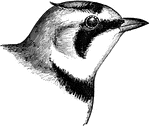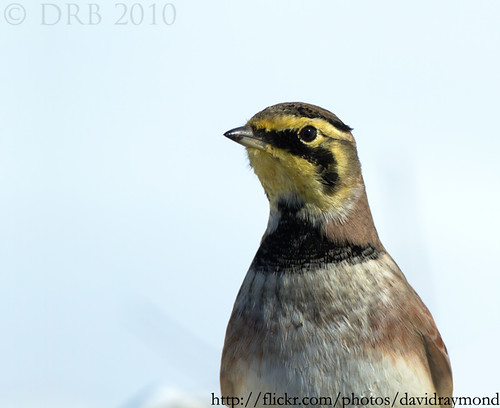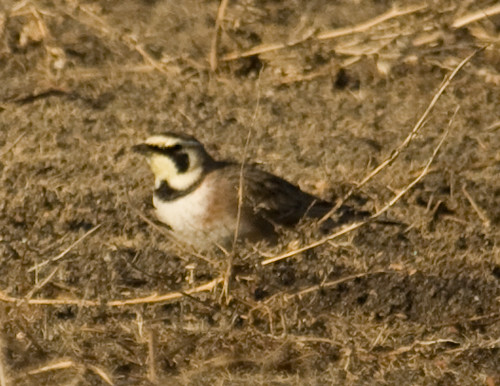
Horned Larks feeding
Image Credit: One Jackdaw Birding
Over the last few weeks, I have done quite a bit of open field birding. As expected, the species of bird that I encountered most frequently was the Horned Lark. The birds are always exciting to see, with their black masks, yellow throats and their batman-like erectile feathers on their heads.
With few exceptions, virtually all the Horned Larks were observed feeding in harvested corn fields or picking grit from the edge of the road. Sometimes, the Horned Larks would be accompanied by other birds, such as Mourning Doves, Snow Buntings and (rarely) Lapland Longspurs. Of course, each time I observed a flock of larks, I was sure to break out my tripod and mount my spotting scope to peruse the flock for these other tag-alongs. After all, you seen one Horned Lark, and you’ve seen them all, right?
Well, that is what I initially thought. While scanning the flocks, I noticed that there were at least two different “types” of Horned Larks present, one with a white supercilium and pale throat, and a second with a yellow supercilium and yellow throat. I initially dismissed it as normal variation. Then last weekend, I was out field birding with Steven Feldstein and he made the same observation. I decided to look into the matter.
As it turns out, Clement’s Checklist of Birds of the World recognizes 41 subspecies of Horned Lark (27 New World and 14 Old World). According to the National Geographic Field Guide to the Birds of Eastern North America, there are two sub-species of Horned Larks that commonly migrate through the eastern US, the “Northern” Horned Lark (Eremophila alpestris alpestris) and the “Prairie” Horned Lark (E. a. praticola). A third sub-species, Hoyt’s Horned Lark (E. a. hoyti), is a very rare eastern migrant.

Horned Lark
Image Credit: USF
All Horned Larks have a black mask which extends from the base of the bill to down below the eye, a black bib at the base of the throat, and black stripes on the flanks of the crown which extent rearward, forming horn-like projections. The face and throat are typically colored white or yellow. The sub-species can be distinguished by careful observation of the head pattern.
Northern Horned Lark

Northern Horned Lark (E. a. alpestris)
Image Credit: David Raymond
The Northern Horned Lark in the nominate sub-species. It breeds primarily in northern Quebec, Labrador and Newfoundland. The Northern can be distinguished by its bright yellow supercilium and throat.
Prairie Horned Lark

Prairie Horned Lark (E. a. praticola)
Image Credit: Kevin Fleming
The Prairie Horned Lark breeds in Southern Canada and the Eastern US. According to Ron Pittaway, its breeding range is separated from the Northern and Hoyt’s Horned Larks by a wide boreal forest. The Prairie is distinguished by its overall paler appearance, pale yellow throat and white supercilium.
Hoyt’s Horned Lark

Hoyt’s Horned Lark (E. a. hoyti )
Image Credit: Marshall J. Iliff
The Hoyt’s Horned Lark breeds in "arctic islands south to northeastern Alberta, northwestern Saskatchewan, northeastern Manitoba, extreme northwestern Ontario”. It migrates primarily through the prairie region west of Lake Superior. Hoyt’s in similar in appearance to the Prairie Horned Lark, except that it is larger. Further, the yellow on the throat is typically paler and restricted to the central region of the throat. As mentioned above, Hoyt’s is a very rare winter migrant to the east.
Based on the observation made in the field, it seems that the differences in appearance of the Horned Larks that were observed around Centre County over the last few weeks correspond to the two common eastern sub-species, the Northern and Prairie Horned Larks.
One additional difference that may be of some interest is that the Northern and Prairie Horned Larks have different spring migration habits. Prairies typically migrate earlier, arriving on the nesting ground in early to mid February. Northern Horned Larks arrive later, in mid-March to early April. As such, the two sub-species we are currently observing could be headed in different directions.



1 comment:
I actually saw the same thing, but it never registered to me. I have seen photos of the Western subspecies on the eBird rarity pool and have been trying to pick some different subspecies out of the flocks around State College. Neat find!
Post a Comment